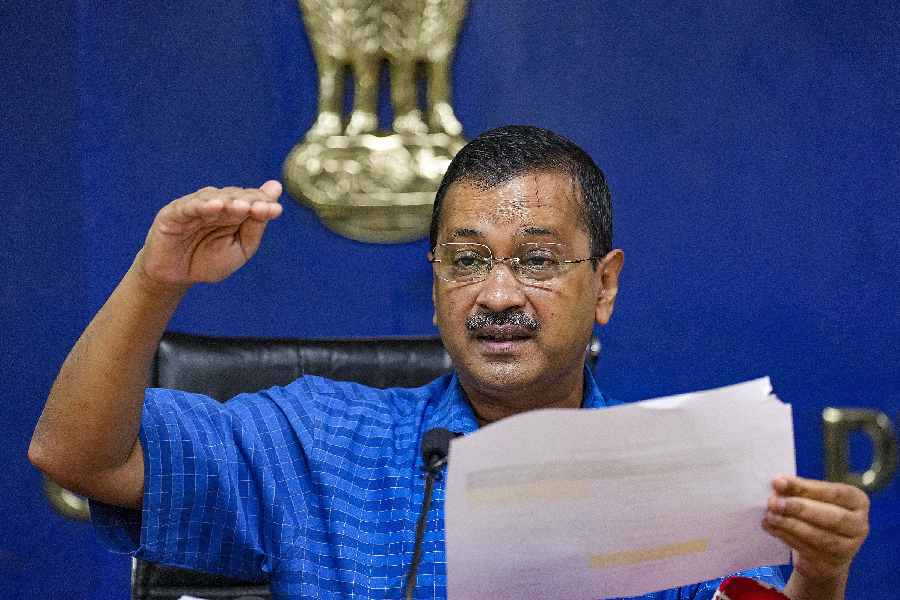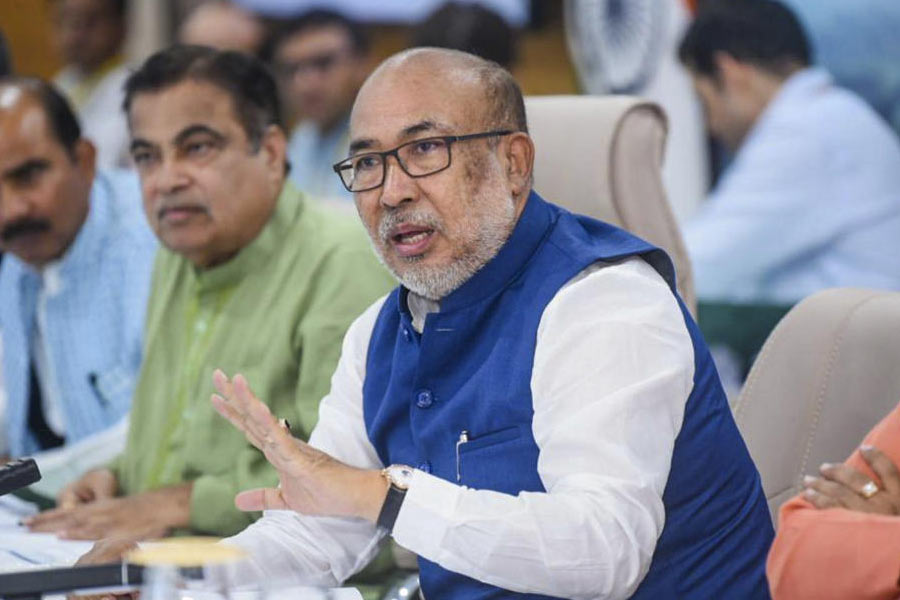The Yamuna in Delhi swelled to 207.83 metres on Wednesday, breaching its all-time record of 207.49 metres set 45 years ago, flooding many areas and prompting Chief Minister Arvind Kejriwal to appeal to people living in low-lying to evacuate immediately.
Thousands of people have been shifted to safer areas as water gushed into their homes and markets near the river, causing them immense hardships.
Waterlogging on parts of the busy Ring Road, including on the stretch between Majnu ka Tila and Wazirabad, led to traffic congestion, officials said.
In view of the grave situation, the Delhi Police imposed prohibitory measures under CrPC section 144 in flood-prone areas of the city, preventing unlawful assembly of four or more people and public movement in groups.
Lt Governor V K Saxena has called a meeting of the Delhi Disaster Management Authority (DDMA) on Thursday over the rising water level of the Yamuna, Raj Niwas officials said.
According to the Central Water Commission's (CWC) flood-monitoring portal, the water level at the Old Railway Bridge crossed the 207-metre mark at 4 am on Wednesday, the first time since 2013. It rose to 207.83 metres by 7 pm on Wednesday.
The water level of the river is likely to rise further, an official of the Delhi Irrigation and Flood Control Department said. The India Meteorological Department has predicted "heavy to very heavy" rainfall to continue in Uttarakhand in the next two days.
"I urge everyone living in low-lying areas to evacuate because the water level will rise suddenly and your life could be in danger," the chief minister said at a press conference.
As the water level rose to a record level, Kejriwal urged the Centre to intervene to ensure that levels of the Yamuna don't rise further.
In a letter to Union Home Minister Amit Shah, he requested that "if possible the water from Hathnikund barrage in Haryana be released in limited speed" and pointed out that Delhi is set to host the G-20 Summit meeting in a few weeks.
"The news of flooding in the capital of the country will not send a good message to the world. Together we will have to save the people of Delhi from this situation," he said.
Kejriwal informed Shah that Delhi did not receive any rain in the last three days, adding that the level of Yamuna in the national capital was not rising due to rain in the city but because of water released into the river from the Hathinikund barrage in Haryana.
Addressing the press conference on Wednesday evening, he said Union Water Minister Gajendra Shekhawat has informed him that the volume of water being released to Haryana from Himachal Pradesh has reduced, which in turn will bring down the water level in the Yamuna.
"Following my letter (to Shah), I got a call from Union minister Gajendra Singh Shekhawat, who said that Hathnikund is just a barrage and there is no reservoir to store water and limit the water speed.
"The water volume being released from Himachal Pradesh has reduced and the situation will improve. But it will take time to reflect in the water level of the Yamuna," the chief minister told reporters here.
Following the meeting, Kejriwal had said that the focus at the moment is to protect lives.
"Please vacate your houses. We have also been seeing that some people are going to watch the swollen river. Please don't go there to click selfies," he urged the people.
He said Boat Club, Monastery Market, Neeli Chhatri Temple, Yamuna Bazar, Neem Karoli gaushala, Vishwakarma Colony, the stretch between Majnu ka Tila and Wazirabad have been submerged.
The chief minister also said that Delhi government has informed NDRF that its help may be sought.
District magistrates have also been directed to convert schools into relief camps, if needed, he said.
The swelling of the Yamuna river led to waterlogging in the Delhi Transport Corporation headquarters area near ITO. Its employees waded through the waterlogged entrance to get into the office on Wednesday.
In northeast Delhi's Garhi Mendu and Usmanpur villages, flood water has risen to over four feet, local MLA Ajay Mahawar said, adding that the residents have already been moved to safety. The power supply was cut off around 4 am.
On Wednesday afternoon, the floodwater reached the Ring Road in several areas, including Majnu ka Tila and Kashmiri Gate. The green belt along the bank of the Yamuna was flooded.
A senior Delhi government official said the irrigation and flood control department has put sandbags to stop the floodwater from entering the Ring Road.
Narrating the problems faced at relief camps, a person said, "It's poor people like us who are suffering... Government makes false promises but does nothing on the ground. We don't get anything." Another flood victim Radhe Kishan sought to vent his anger at the government saying, "Last year too the area had got flooded. The government has hardly done anything since then and the situation remains the same." "The government could have at least made arrangements for food. But that is being provided by a gurdwara," he said.
A shopkeeper at north Delhi's Monastery market alleged that the government has not done anything.
"Our goods have been destroyed. This is like Venice," another person said, pointing towards the flooded market. The shopkeepers at the Monastery market were busy shifting their goods.
The national capital on Wednesday witnessed traffic snarls in many areas due to waterlogging, damaged roads and movement of Kanwarias.
Revenue Minister Atishi said the Delhi government is strengthening river embankments and evacuating people out of the floodplains.
The Delhi Disaster Management Authority issued an advisory asking people to move to safer places and cautioned them against passing through low-lying areas.
As the flood situation persisted in the Yamuna river, people should stay away from power lines and reach out to the helpline 1077 in case of any need, it said.
The water level in the Yamuna river has risen rapidly over the past three days. It shot up from 203.14 metres at 11 am on Sunday to 205.4 at 5 pm on Monday, breaching the danger mark of 205.33 metres 18 hours earlier than expected.
The river had exceeded the evacuation mark of 206 metres on Monday night, prompting the relocation of people residing in flood-prone areas to safer locations and a closure of the Old Railway Bridge for road and rail traffic.
Water minister Saurabh Bharadwaj told reporters that the Delhi government was prepared to deal with the situation. "We are monitoring the situation and all possible steps are being taken," he said.
Major floods in Delhi occurred in 1924, 1977, 1978, 1995, 2010, and 2013. Analysis of flood data from 1963 to 2010 indicates an increasing trend for floods in September and a decreasing trend in July.
As the water level of the Yamuna in Delhi breached the all-time record of 207.49 metres set in 1978, experts attributed the situation to the encroachment of floodplains, extreme rainfall in a short duration, and the accumulation of silt, which elevated the riverbed.
A senior official at the Central Water Commission (CWC) said, "We noticed that the water released from the Hathnikund Barrage took less time to reach Delhi compared to previous years. The main reason could be encroachment and siltation. Earlier, the water would have had more space to flow. Now, it passes through a constricted cross-section." The water from the barrage at Yamunanagar in Haryana, around 180 kilometres from the national capital, takes two to three days to reach Delhi.
Northwest India saw incessant rainfall over the weekend with many areas in Jammu and Kashmir, Uttarakhand, Himachal Pradesh, Haryana, Uttar Pradesh and Rajasthan recording "heavy to extremely heavy" rains.
Except for the headline, this story has not been edited by The Telegraph Online staff and has been published from a syndicated feed.










